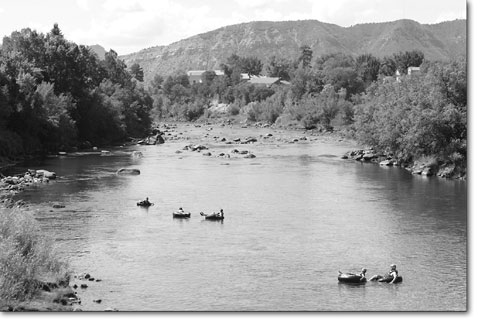| ||
| The politics of whitewater Opposition to recreational water rights eases SideStory: Setting up the rules for recreation: Hearing set for Sept. 12
by Will Sands
Threats of opposition have mellowed into offers of cooperation on the Animas River. An effort to keep water in the Animas purely for recreation heated up earlier this summer, when a push by the City of Durango met not only resistance, but the potential for a protracted legal fight. However, the waters have grown calmer recently, and recreational water rights on the Animas River could go forward with the support of the Southwest Water Conservation District (SWCD). The Durango City Council will weigh its options in coming weeks. The city first began exploring a recreational in-channel diversion for the Animas early in the summer of 2004. Such a water right would reserve flows specifically for rafting and kayaking on the Animas as it passes through the city. The move would not add water to the river, but merely safeguard current flows from future growth and development or transmountain diversions upstream. The plan drew strong reactions from the SWCD during a council study session July 12 this year. At that time, the district relayed its opposition to a recreational filing, saying it was unnecessary. The district continues to believe that the conditions on the Animas River ensure an abundance of water flowing through Durango. “There is extra water in the Animas River, and rafters and kayakers have access to that water as is,” said Fred Kroeger, SWCD board president. “People have said they have concerns about new development filing for that water, but essentially that is impossible.” Kroeger explained that new development is actually not that demanding in terms of water use. For example, Silverton would need only 1 more cubic foot per second (cfs) if it doubled its current population, he noted. While no figures have been forwarded for the proposed recreational water right, it would be at least several hundred cfs. “The Southwest Water Conservation District is charged with protecting and utilizing the waters of the San Juan Basin. We just don’t think this is well thought out,” Kroeger noted. Proponents of preserving the river for recreation counter that growth and development could have a stronger impact in coming decades. The diversion of water from the Animas Basin into an adjacent drainage is also a possibility, they say. “I agree that there is plenty of water in the stream right now,” said Chuck Wanner, water issues coordinator with San Juan Citizens Alliance. “If you can sign the paper and guarantee that it will be that way in 30 years, I’d be happy to go for it.” Wanner added that he is suspicious of the charge that development uses very little water. “If the water’s available, you can apply for it,” he said. “There’s no established principle that says there might be a development someday and we should make sure there’s plenty of water available for ‘joe developer.’” Jack Rogers, Durango Public Works director, has a more specific long-range concern. “I think everyone understands that a recreational in-channel diversion will only help solve the long-range problem of someone coming down and finding a way to transport water out of the Animas and into some other basin,” he said. Rogers concurred that there is currently an abundance of water flowing through the Animas, saying, “The river’s very rarely on call. People can use the water above Durango, basically without even having a water right.” However, there is still a valid interest in preserving flows for recreation on the Animas, he said. “People who are interested in the recreational in-stream diversion think it’s still a useful purpose and worth the administrative and legal costs of proceeding through the water court process.” The SWCD still does not believe a recreational right on the Animas is a useful purpose. However, the district has gone from opposing it to offering cautious cooperation. Kroeger explained that the district is charged with looking out for water rights in the San Juan and Dolores river basins. This encompasses a giant geographic area including the Animas, Piedra, San Juan, Dolores, La Plata, San Miguel and other rivers. “If we get involved, we might be able to set some examples and get ahead of the ball for other recreational in-channel diversions,” Kroeger said. “Plus, we think we can do this without getting sued.” Kroeger then added, “We still think it’s foolish for the city to do this, but if they insist on doing it, let us help them, and we’ll go for a reasonable amount of water.” The “reasonable amount” of recreational water is still up for debate. Also up for debate is whether the city will officially apply for a recreational in-channel diversion. There is hope that some direction will materialize during the Colorado Water Conservation Board’s local rulemaking hearing Sept. 12 (see sidebar). The conservation board is the agency charged with regulating in-stream diversions. “Having the Colorado Water Conservation Board in Durango might give us a chance to meet with the bard and see how they’re leaning,” Rogers said. “It could save us a lot of money if we knew up front if they’re going to be in opposition.” •
|


